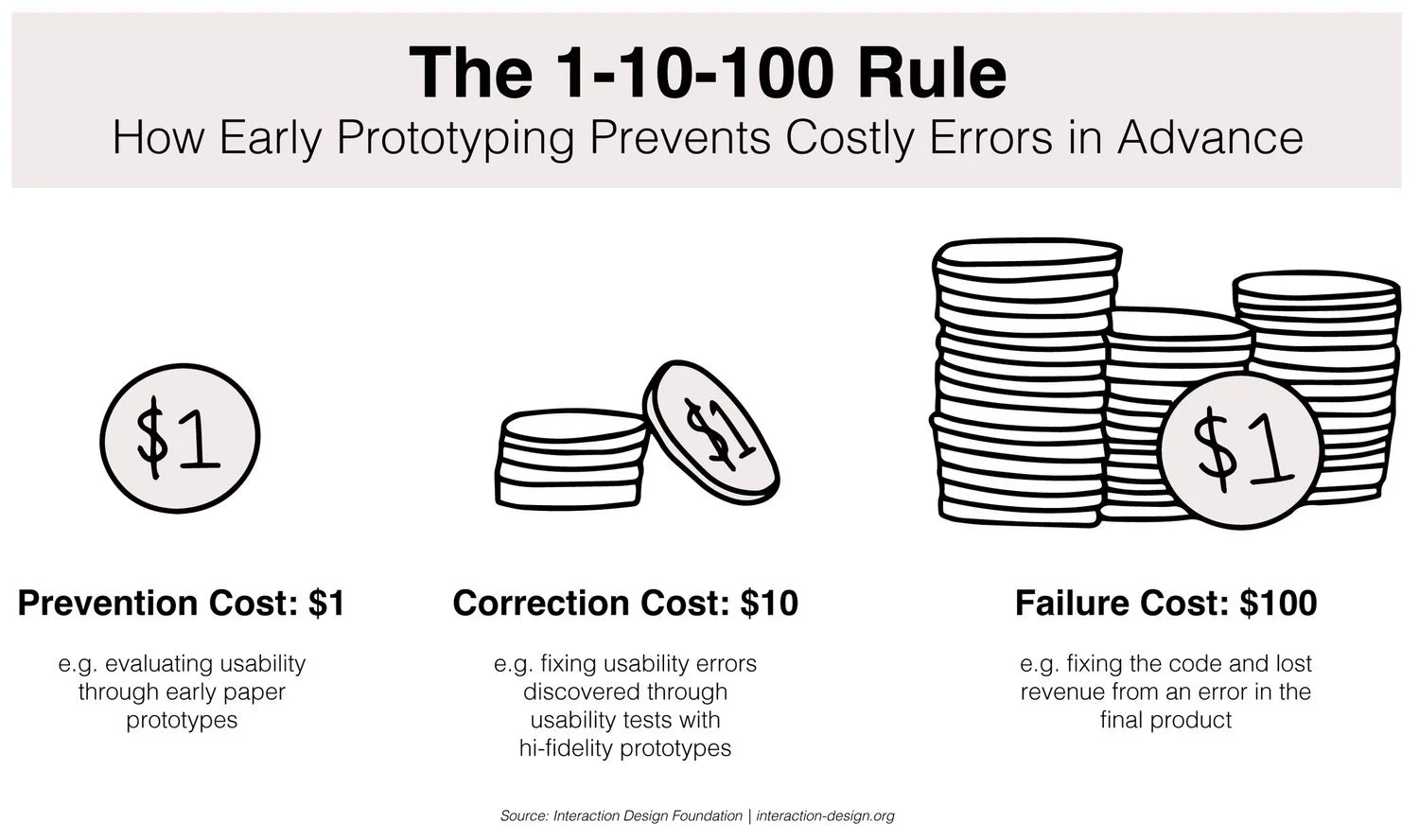Implementation starts with prototyping
Key Insights
What people think, say and do are three different things.
Prototyping is the process of creating tangible artefacts that need to be fleshed-out enough to approximate a realistic experience and clear enough to stand on their own.
Prototypes are not solutions; they are a way of asking questions.
Prototyping is a cost-effective way to help us to realise quickly whether an idea resonates with people or not.
A successful prototyping strategy requires an organisational culture of experimentation.
If a picture is worth 1000 words, a prototype is worth 1000 meetings.
Last time I talked about the importance of having a clearly articulated idea in the form of a concept in order to create more certainty around implementation. This month we look at prototyping’s role in implementation success. A design concept on its own is not enough to ensure implementation success. It is very risky to move into implementation directly off the back of a freshly developed concept. What people think, say and do are three different things. While it is essential to understand what people think and say, we will only understand their real intent from watching what they do. Prototyping is helping us to understand what people really do. I was recently talking to an executive about the slow take-up of their newly launched product. She said that in a survey conducted before launch, more than 80% of responders indicated they would be more likely to purchase the company’s products. The reality was a different outcome. The problem? This company didn’t have a prototype. They didn’t test people's true intent, and the outcome spoke for itself.
Why prototyping?
With high-level concept design we achieve an understanding of potential customer desire. Once we complete resonance testing of the concept, it’s time to determine if we can actually build it (feasibility) and how we can make money from it (viability). That’s the foundation for our business case. The first step towards moving into concrete implementation is a low fidelity prototype. Testing the prototype reduces the risk of failure and provides a clear guide around true market desire.
Let’s delve into why the prototype is so important for implementation success.
Approximate an experience
Prototyping is the process of creating tangible artefacts. A tangible artefact is not an abstract description that requires interpretation. It needs to be fleshed-out enough to approximate a realistic experience, and clear enough to stand on its own (see next point). Emphasis is on the word ‘approximate’. We need to start with a high-level simulation of the desired experience. From there we can develop an offer and test people's reactions in focus groups.
Tangible artefacts prompt questions
Prototypes are not solutions; they are a way of asking questions. We always tend to explain our idea in detail, but with the prototype, we need to create tangible objects that people can understand without our interpretation. Whilst observing my MBA students testing their prototypes, I often witnessed them falling into the trap of being the ones to ask the questions and then trying to provide the answers to their users. In a successful prototype test, it must be the other way around.
A cost-effective way to validate assumptions
Prototyping helps us to realise quickly whether an idea resonates with people or not. This approach forces us to slow down before we speed up. Paper prototypes may cost hardly anything, but the learning is enormous. As a business, we often keep dragging our ideas internally, leading us to give up on them quickly. On the other hand, sometimes we go as far as starting to implement complex ideas only to realise they are not right. This is causing a lot of frustration as we spend so much time going around in circles without solving the problem. Prototyping is a very quick way to reach certain resolution. As Tom and David Kelley would say: “If a picture is worth a 1000 words, then a prototype is worth a 1000 meetings”
Manage funding risk
One of the key benefits of the prototyping phase is to validate our assumptions, which in turn reduces the risk of investing money in an aspect of our solution where people don’t see the value. Let’s take a look at the 1-10-100 rule, which explains how prototyping helps us manage the risk of funding.
Prototyping helps us in many aspects of solution development by:
Providing a solid foundation for how certain aspects of our offer are perceived. Stakeholders can get a picture of the potential benefits, risks and costs associated with the direction of the new concept.
Interacting with a solution to determine which elements/variants work best and whether an overhaul is required.
Enabling us to adapt to changes early. It helps us understand which aspects work so we can avoid high costs due to oversights.
Providing a sense of reality to stakeholders. This will help diffuse personal biases toward the solution.
Helping to speed up time to market by minimising the number of errors to correct before product release.
How to make a prototype
Not sure how to start with prototyping? The good news is that there’s a structured way to do it. After that, it’s just a matter of your own creativity and leadership patience with iterations. Without going into specific details, let’s explore some directional steps.
Plan - We need to start with planning. Create a list of features that make or break our initial concept. This forces us to go back and review our customer insights and validate whether we find any association between these and our potential features.
Build - Collect all necessary material/software and start building a prototype. It doesn’t need to be complicated. Start as simple as possible.
Test - Once we are comfortable with what we’ve built, test the prototype with the key customers identified during the planning in stage 1.
Refine - Finally, we need to refine the prototype based on findings highlighted during testing, and incorporate any additional aspects that will go into the next level of testing.
Repeat - We repeat this as many times as required until we are confident that people are comfortable with the interactions and experience.
Build an internal culture of experimentation
Having an organisational culture of experimentation is perhaps one of the most critical factors in a prototyping strategy, but unfortunately is also the hardest to change. For prototyping to be successful, significant mindset shifts and discipline implementing strategic planning actions are required.
We had an experience where we were preparing a prototype for testing with one of our clients. We were told that we couldn’t do it without a sign-off from a senior executive. When we showed him the prototype, the executive was disappointed with how it looked, telling us we couldn’t test with people using these ‘funny sketches.’ According to him, we needed professional, glossy images aligned with the brand, amongst many other things. We argued that the more ‘agile’ the prototype, the better engagement we get from the people we tested with. People in nature want to help, and as a result empathise better if we ask for help through low fidelity prototypes. Eventually we convinced this senior executive to join us at the testing. Let’s just say what he learned from these ‘funny sketches’ was an eye-opener on more than one account.
In another organisation, an investment committee accepted suggestions to establish a process in which business owners pitch for seed funding using prototypes. The process created completely different conversations during the investment committee meetings. Another organisation, seeing the benefits, introduced the mandate to “never go to a meeting without a prototype”. The results provided much better organisational alignment and enhancement for continued further development of products and concepts.
Prototyping creates clarity and measurable validation for our concepts against customer desirability and usability. It reduces funding risks and provides cross-organisational alignment, eliminating wasted time from unnecessary meetings and building confidence. If the goal is to get the best product to market in the quickest time, the solution is down the path of the prototype.
Next Steps:
There are many more examples of how to embed experimentation culture and prototyping into established organisations. Maybe you have experimented with your own. I would be keen to hear from your experiences. Let’s continue this INNOVATION CONVERSATION together - reach out to me: munib@wave.design.
This article has been written by Dr Munib Karavdic, CEO of WAVE Design and Conjoint Professor of Intrapreneurship at AGSM/UNSW. Get in touch with Dr. Karavdic here.
Get in touch
Interested to learn more about how to start your implementation process with prototyping? Get in touch with one of our senior designers to discuss how we can help.




